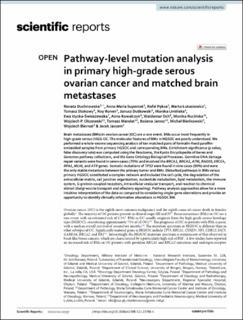Pathway‑level mutation analysis in primary high‑grade serous ovarian cancer and matched brain metastases
| dc.contributor.author | Duchnowska, Renata | |
| dc.contributor.author | Supernat, Anna Maria | |
| dc.contributor.author | Pęksa, Rafał | |
| dc.contributor.author | Łukasiewicz, Marta | |
| dc.contributor.author | Stokowy, Tomasz | |
| dc.contributor.author | Ronen, Roy | |
| dc.contributor.author | Dutkowski, Janusz | |
| dc.contributor.author | Umińska, Monika | |
| dc.contributor.author | Iżycka-Świeszewska, Ewa | |
| dc.contributor.author | Kowalczyk, Anna | |
| dc.contributor.author | Och, Waldemar | |
| dc.contributor.author | Rucińska, Monika | |
| dc.contributor.author | Olszewski, Wojciech P. | |
| dc.contributor.author | Mandat, Tomasz | |
| dc.contributor.author | Jarosz, Bożena | |
| dc.contributor.author | Bieńkowski, Michał | |
| dc.contributor.author | Biernat, Wojciech | |
| dc.contributor.author | Jassem, Jacek | |
| dc.date.accessioned | 2023-01-24T08:47:02Z | |
| dc.date.available | 2023-01-24T08:47:02Z | |
| dc.date.created | 2022-12-14T10:27:09Z | |
| dc.date.issued | 2022 | |
| dc.identifier.issn | 2045-2322 | |
| dc.identifier.uri | https://hdl.handle.net/11250/3045679 | |
| dc.description.abstract | Brain metastases (BMs) in ovarian cancer (OC) are a rare event. BMs occur most frequently in high-grade serous (HGS) OC. The molecular features of BMs in HGSOC are poorly understood. We performed a whole-exome sequencing analysis of ten matched pairs of formalin-fixed paraffin-embedded samples from primary HGSOC and corresponding BMs. Enrichment significance (p value; false discovery rate) was computed using the Reactome, the Kyoto Encyclopedia of Genes and Genomes pathway collections, and the Gene Ontology Biological Processes. Germline DNA damage repair variants were found in seven cases (70%) and involved the BRCA1, BRCA2, ATM, RAD50, ERCC4, RPA1, MLHI, and ATR genes. Somatic mutations of TP53 were found in nine cases (90%) and were the only stable mutations between the primary tumor and BMs. Disturbed pathways in BMs versus primary HGSOC constituted a complex network and included the cell cycle, the degradation of the extracellular matrix, cell junction organization, nucleotide metabolism, lipid metabolism, the immune system, G-protein-coupled receptors, intracellular vesicular transport, and reaction to chemical stimuli (Golgi vesicle transport and olfactory signaling). Pathway analysis approaches allow for a more intuitive interpretation of the data as compared to considering single-gene aberrations and provide an opportunity to identify clinically informative alterations in HGSOC BM. | en_US |
| dc.language.iso | eng | en_US |
| dc.publisher | Nature Research | en_US |
| dc.rights | Navngivelse 4.0 Internasjonal | * |
| dc.rights.uri | http://creativecommons.org/licenses/by/4.0/deed.no | * |
| dc.title | Pathway‑level mutation analysis in primary high‑grade serous ovarian cancer and matched brain metastases | en_US |
| dc.type | Journal article | en_US |
| dc.type | Peer reviewed | en_US |
| dc.description.version | publishedVersion | en_US |
| dc.rights.holder | Copyright The Author(s) 2022 | en_US |
| dc.source.articlenumber | 20537 | en_US |
| cristin.ispublished | true | |
| cristin.fulltext | original | |
| cristin.qualitycode | 1 | |
| dc.identifier.doi | 10.1038/s41598-022-23788-4 | |
| dc.identifier.cristin | 2092910 | |
| dc.source.journal | Scientific Reports | en_US |
| dc.identifier.citation | Scientific Reports. 2022, 12, 20537. | en_US |
| dc.source.volume | 12 | en_US |
Tilhørende fil(er)
Denne innførselen finnes i følgende samling(er)
-
Department of Clinical Science [2297]
-
Registrations from Cristin [9558]

